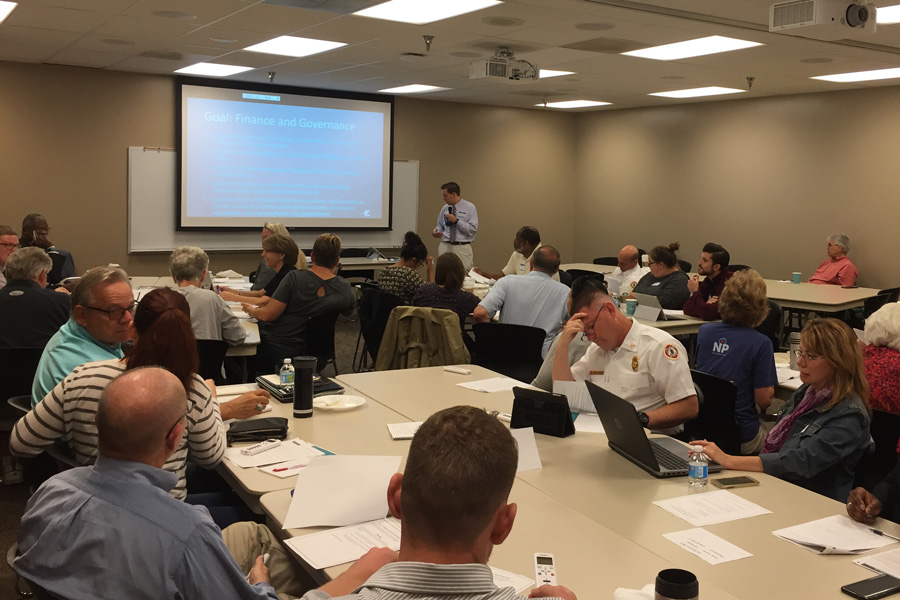10,000 to 49,000 Population

Can You Afford to Not Know? Lake Zurich’s 20-Year Community Investment Plan
Lake Zurich, Illinois
Ray B. Keller, ICMA-CM, Village Manager
Roy T. Witherow, ICMA-CM, Assistant Village Manager
Jodie Hartman, Director of Finance
“Can we afford to not know?” That was the question Lake Zurich, Illinois, asked itself when considering its long-term infrastructure and equipment needs. The village had maintained a five-year capital infrastructure program and an accompanying vehicle replacement schedule, and it successfully funded smaller projects and replacement vehicles on an annual basis whenever possible. But these limited tools did not provide a strategic view of the village’s long-term equipment or infrastructure needs. Furthermore, the village found itself deferring large infrastructure upgrades for budget reasons, and occasionally it faced an emergency—such as failures of two key sewer lines—for which emergency repairs were far more expensive than they would have been if they had been planned and competitively bid.
In 2017, determined to make capital investment more intentional, the village surveyed, evaluated, and prioritized the community’s capital and equipment needs for the next twenty years through a Community Investment Plan (CIP). This approach enabled the village to better plan for these costs over a longer time period and avoid disrupting operations or compromising essential infrastructure.
A core team from the village manager’s office and the departments of innovation, finance, and public works worked with every department to prepare a standardized “asset page” for each piece of equipment, vehicle, or infrastructure element that exceeded $20,000 in value. Each asset/project was rated based on its current condition, priority ranking (1 to 4), life expectancy, and replacement cost. Priority 1 projects reflect either an imminent threat (e.g., a compromised sewer) or a regulatory requirement. Priority 4 projects are complementary or enhancement projects, including those contingent on opportunistic funding (e.g., impact fees, grants), which are listed separately. All projects are ultimately integrated into a master list based on priority, cost, and timeline for subsequent replacements.
The resulting CIP was immediately incorporated into the FY 2018 budget. Elected officials and the broader community embraced the effort, praising how the information informed their decision making, particularly the elegantly simple design of the asset pages and the easy-to-understand project lists. The project also enjoyed successful buy-in from departments, including working supervisors, superintendents, and administrative assistants.
In FY 2018, the CIP guided the prioritization of approximately $11.8 million in infrastructure and equipment investments across all funds. It helped the village recognize the longer-term impacts of individual decisions, such as whether to replace specific vehicles on schedule.
While the final analysis and its cost total was sobering, the community investment plan also provided reassurance: the village has a good understanding of what needs to be done and when, and it provides a guide for making intentional capital investments. To maintain its relevance, the CIP will be updated every other year.
50,000 and Greater Population

“Connecting the Dots”: The Evolution of KCMO’s Strategic Planning Process
Kansas City, Missouri
Troy Schulte, City Manager
Scott M. Huizenga, Budget Officer
Debbie Chiu, Budget Operations Manager
Kitty Steffens, Analyst
Like many communities, Kansas City, Missouri (KCMO) had a series of valuable (but disconnected) management policies and processes, including a strategic plan, an annual budget, financial forecasts, annual financial reports, and departmental strategic plans. The city also implemented KCStat, a public-facing, data-driven management system in which management monitors the performance of city departments in real time. Each of these had value, but the pieces had not been put together to present a cohesive direction for the city.
In 2013, City Manager Troy M. Schulte directed the Finance Department to develop a comprehensive, renewable five-year Citywide Business Plan (CWBP) with three essential components: (1) the city’s strategic plan, including mission, vision, values, goals, and objectives; (2) a financial strategic plan, containing financial objectives; and (3) a five-year planning model that provides baseline and balanced scenarios to evaluate financial and operational alternatives through the planning and budget process. A city charter change in 2014 required the production of the financial strategic plan and the five-year planning model every year, giving impetus to the development of this new blueprint to guide the city’s policy and financial decisions.
As the CWBP was developed, the city’s Office of Management and Budget (OMB) conducted resident work sessions throughout the city to ensure that the plan was informed by input from the community.
Kansas City’s strategic plan has grown to include seven goals, with 30 departmental objectives and 131 strategies. Through the development of strategies, city departments and divisions can define what steps they must take to achieve the objectives. Each goal, strategy, and action has an owner who is accountable for moving projects forward and reporting specific obstacles when they occur.
In 2016, the city chose Stratex Solutions as a partner to execute and track the progress of actions in the Citywide Business Plan. The Stratex software is monitored and maintained by OMB, and progress is reported through the KCStat program by the city’s performance management office. The software allows the city to assign human resources to tasks and track the hours spent. This tracking elucidates the resources required to achieve the strategies and highlights the need to confirm priorities and rethink timelines, if necessary.
OMB holds regular team meetings to discuss issues that might prevent actions or projects from moving forward. This team-oriented review reinforces the collaborative nature of the plan while holding individuals accountable for action. It allows for creative problem-solving and provides a mechanism for management to expediently respond where attention is needed.
This KCMO strategic planning process has three critical pieces: (1) a public-facing document that provides a holistic look at city priorities developed by departmental leadership, (2) an active engagement process that directly links city staff to residents, and (3) an inward-facing mechanism to promote collaboration and accountability in achieving goals. The project directly connects community managers with administrators, reinforcing the message that the city is actively managing with flexibility and a long-term vision.
